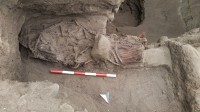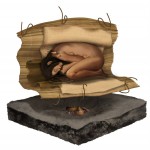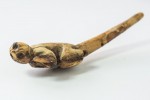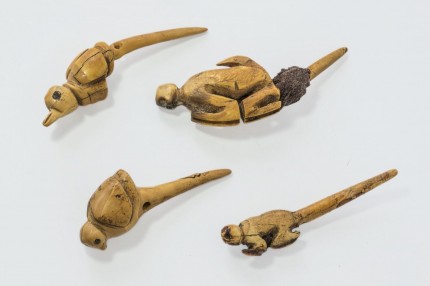 Archaeologists have discovered a 4,500-year-old burial at the archaeological site of Aspero, an ancient preceramic fishing town in northern Peru. Analysis of the bones revealed that the deceased was a woman about 40 to 50 years of age at the time of death. The burial was found in the Huaca of the Idols, one of two monumental platform mounds (earthwork terraced pyramids shored up with quarried stone walls and river rock fill which ranged in size from modest to huge) in the town. Her crouched body was wrapped in three layers, the inner two of cotton, the outer of reeds which was fastened closed with rope. Buried with her was a pottery vessel containing the remains of vegetables and seeds, a bead necklace, a Spondylus pendant and four tupus, bone brooches carved in the shapes of birds and monkeys.
Archaeologists have discovered a 4,500-year-old burial at the archaeological site of Aspero, an ancient preceramic fishing town in northern Peru. Analysis of the bones revealed that the deceased was a woman about 40 to 50 years of age at the time of death. The burial was found in the Huaca of the Idols, one of two monumental platform mounds (earthwork terraced pyramids shored up with quarried stone walls and river rock fill which ranged in size from modest to huge) in the town. Her crouched body was wrapped in three layers, the inner two of cotton, the outer of reeds which was fastened closed with rope. Buried with her was a pottery vessel containing the remains of vegetables and seeds, a bead necklace, a Spondylus pendant and four tupus, bone brooches carved in the shapes of birds and monkeys.
 The wrapping of the body, the location of the burial and grave goods indicate the woman was a high rank personage of the Caral civilization, the oldest civilization in the Americas which dominated a network of settlements in the coastal area of north-central Peru from around 3500 B.C. to 1800 B.C. First explored in 1905, Aspero was one of the first Caral sites identified by archaeologists before it was recognized as a civilization. Thorough, extensive archaeological documentation of the sites only began in the 1990s under the leadership of Dr. Ruth Shady (no relation to Slim) who named the civilization after the inland town of Caral which is believed to have been the biggest city and the oldest urban center in the Americas.
The wrapping of the body, the location of the burial and grave goods indicate the woman was a high rank personage of the Caral civilization, the oldest civilization in the Americas which dominated a network of settlements in the coastal area of north-central Peru from around 3500 B.C. to 1800 B.C. First explored in 1905, Aspero was one of the first Caral sites identified by archaeologists before it was recognized as a civilization. Thorough, extensive archaeological documentation of the sites only began in the 1990s under the leadership of Dr. Ruth Shady (no relation to Slim) who named the civilization after the inland town of Caral which is believed to have been the biggest city and the oldest urban center in the Americas.
 Dr. Shady and her team discovered the remains of the woman in Aspero. The combination of coastal and inland animals represented in the tupus is evidence of the close economic and cultural connection between the fishing-rich sites along the coast and the agricultural interior. Other than edible plants, the inland Caral towns appear to have focused on growing cotton which the coastal sites needed for their fishing nets. There’s also some evidence of maize being grown as a grain staple, but it seems fish was the primary source of food for coastal and interior towns.
Dr. Shady and her team discovered the remains of the woman in Aspero. The combination of coastal and inland animals represented in the tupus is evidence of the close economic and cultural connection between the fishing-rich sites along the coast and the agricultural interior. Other than edible plants, the inland Caral towns appear to have focused on growing cotton which the coastal sites needed for their fishing nets. There’s also some evidence of maize being grown as a grain staple, but it seems fish was the primary source of food for coastal and interior towns.
With the archaeological study of these sites still being in its adolescence if not infancy, the discovery of the burial of a high status woman will provide new insight into Caral society.
Shady noted the importance of this discovery to further understand the dynamics of the oldest social organization in the Americas. […]
“This find shows evidence of gender equality, that is, both women and men were able to play leading roles and attain high social status more than 1,000 years ago,” Shady underlined.
